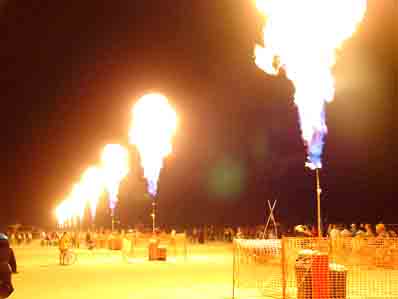| ORDER/SUBSCRIBE SPONSORS CONTACT WHAT'S NEW INDEX/SEARCH HOME | |||||
The Leonardo GalleryThe Burninator IIby Bill Codding
In spring 2005, I built The Burninator Jr., a small 20-ft interactive installation of sequenced fire nozzles that allowed audience members to run its controls and make patterns of fire along its length. The reaction was great: People loved the flames and the interactivity, and so I thought---why not make it bigger? The resulting Burninator II is a large-scale fire installation consisting of 12 flame towers spread over 1,000 feet. It was first built at Burning Man 2006 by myself, my crew (Simon Asato and Dave Bixler) and many volunteers. Sequencing software allowed patterns of fire to be run over the towers spread along an open expanse of desert. Up close, it gave spectators a visceral rush as flame moved at the speed of sound toward them, and from afar (as far as 10 miles away) moving patterns of light and shadow could be seen as flames moved across the towers. Here is the basic system, working backwards: The fire at each tower is controlled by an industrial-strength solenoid valve that switches the pressurized fuel on and off. More than a mile of wires buried in the desert floor connect those solenoids directly to relays on a relay board, which are in turn driven by digital outputs on an Ethernet-based I/O board. Custom Java sequencing software on a laptop computer drives the state of the outputs (and thus the towers) according to programmed or random sequences. These sequences are run by invoking one of a variety of user interfaces: a graphical user interface (on the laptop), an RFID (radio frequency identification) reader reading coded cards, or beams of light broken by spectators. The sequences are the "paintbrushes" that allow light, shadow, sound and fire to be painted on the canvas of the large expanse of open desert (these paintbrushes use 3/4 ton of propane per night; carbon dioxide offsets were purchased to mitigate the effects of burning that much fossil fuel). The goal of the various interfaces was to move the audience one layer back from the system controls so as to make the installation safely interactive. Fire art is often a kind of black art---the installations are behind perimeters; one might be able to see it working, but for the most part one cannot expect to be able to approach the controls. Given the nature of such large-scale fire art, it is often difficult or impossible, especially when building it in an urban workshop, to test or fully predict the qualities of the entire piece before it is actually installed. Individual components were of course tested beforehand---one tower, the software, the valves, the relays and the safety systems (tip sensors, fire sensors, automatic shutoff valves), but the first time anyone saw it running was also the first time I saw it. Many things could go wrong, and there still was the question whether the size and the power of the flames would be spectacular enough to justify the months of labor, the expense and an art grant from Burning Man. I was relying on my preliminary testing and my experience. It worked well. From close by, the installation had a visceral quality, which I had not fully expected, in the rush of sound and reverberations as the flames roared by. (I later tuned the speed to be near the speed of sound---when the fire was moving toward an observer, all the sound would arrive with the closest flash.) Again the reaction was great---people loved the sound, the changing shadows of nearby objects and the sequences of flame visible from anywhere in Black Rock City; someone sitting 10 miles away reported watching the sequences moving over the chaos of the city. People also loved controlling the power of the flames themselves. That power is one of the attractions of fire art and one of the elements of fire art that I like to explore; I feel that the beauty of fire, and art created with fire, is enhanced by the power inherent in the flames and the respect and sense of fear that come along with it. They compel the viewer to look straight at the flames; they grab and focus one's full attention and force one to see the art with no distractions. I am an aerospace engineer by education; I like to use technology to create art and control fire. I do not think there are many of us fire artists who qualify as pyromaniacs---rather than having a compulsion to play with fire, I believe we have a compulsion to harness and control its power in safe and creative ways. Bill Codding www.4bc.org/burninator | |||||
|
Updated 13 April 2007. |
|||||









